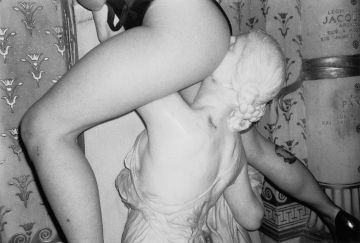Les Statues Meurent Aussi
‘I am beautiful, O mortals! Like a dream of stone...’ Charles Baudelaire, Beauty (1857)
‘When men die, they become history. Once statues die, they become art. This botany of death is what we call culture.’ This is how the film by Alain Resnais and Chris Marker ‘Les statues meurent aussi’ (1953) begins.
Marianne Marić takes up this beautiful banner ‘Les statues meurent aussi’ to title a photographic series where this botany of death, called culture, is staged in reverse. Living models appear, friends and muses of the artist, naked or partially naked, in a physical relationship, sometimes acrobatic and whimsical, always erotic, with marble or bronze statues that seem reanimated by this intimacy with the living. The love of statues has a name: agalmatophilia. ‘Numerous accounts attest to the fact that one can have a connection with works of art that comes closer to the passion of love and its fetishistic variants than to the serene and contemplative delight that is often attributed to the connoisseur. [...] From the love of art to actual love, would it only be a small step?’, says neurologist and science historian Laura Bossi at the opening of her book ‘De l'agalmatophilie’ (2012). It all began with Pygmalion in Ovid's Metamorphoses, who fell in love with his creation, a statue brought to life by the goddess Venus. Removed from the botany of death, from culture, from the status of a work of art, the statue becomes a simulacrum: an ambiguous state born of human illusion and divine - or photographic - spell. This ambiguity in Marianne Marić's series seems to act on the lives of her models, captured by the camera's flash and petrified by the pose. This carnal ambiguity of that which is alive being grasped by the dead and vice versa, of the figure coming to life and the body freezing, is also the staging or division of the body as object and subject: what is the nature of the model? As a model who desires and also an object of desire, the photographer's model is a double agent.

